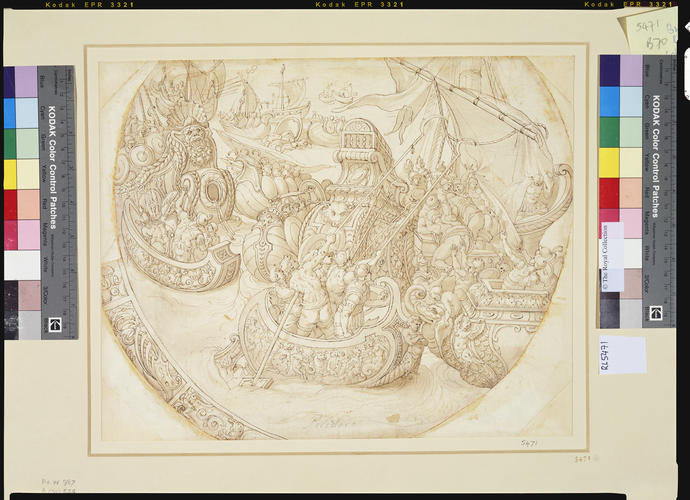The Battle of the Morbidhan Gulf c. 1560
pen and ink and wash over black chalk, incised, circular, pasted on two sheets of paper, cut | 35.2 x 28.3 cm (sheet of paper) | RCIN 905471
-
This drawing corresponds to the design found on the interior of a decorated wine cooler probably made for Cosimo I de’ Medici, Grand Duke of Tuscany, now in the Wallace Collection (Inv. C107).
The scene depicts the battle of the Morbihan Gulf (56 B.C.), when Julius Caesar destroyed the Veneti tribe of modern Brittany. The subject of the Life of Caesar was employed in a series of maiolica dishes commissioned by the Duke of Urbino as a present for Philip II King of Spain. The Service was sent from Urbino to the court of Philip II in 1562, however it is not known whether it had reached the Spanish court or was eventually dispersed. The prestigious service, called the ‘Spanish Service’ or ‘Credenza Spagnola’, presumably contained hundreds of pieces, including dishes and basins. Many are now in the Bargello, Florence (inv. 1764), and the Victoria and Albert Museum (7159-1860). The Service was probably made in the workshop of Flaminio Fontana in Urbino in 1560-62, after designs by Taddeo Zuccaro.
The inscription on the base of the Wallace cooler, ‘F.F.F. / VRBINI / 1574', indicates that it was made in the Fontana’s factory in 1574, suggesting that this piece did not form part of the ‘Spanish Service’, completed by 1562. Instead, the cooler belongs to a different project, identified by Marco Spallanzani (‘Maioliche di Urbino’, Faenza, LXV, 1979, pp. 111-126) as a piece intended for Cosimo de’ Medici (1519-74) and described in the 1571-87 inventory of the guardaroba of Cardinal Fernando de’ Medici as part of a consignment of forty-three pieces delivered by Flaminio Fontana in 1573. The different decorative motifs visible on the lower left of the drawing also differ from the Raphaelesque grotesques present on the Spanish dishes. For this reason, a direct connection with the Wallace Collection piece is not fully accepted by scholars. Zuccaro’s designs were copied and used to produce fac similes of the Service and it is likely that the present drawing was made with this purpose. As Oberhuber (1977, 38) noted, the inferior quality of the drawing indicates that this could be a working drawing produced by one of Taddeo’s assistant, presumably after a drawing by Taddeo with the same composition and decorative border in a private collection in the United States dated 1560-62 (illustrated in Acidini Luchinat 1998, p. 29). Another copy is at Oxford, Christ Church (inv. 1574). The old attribution to Polidoro da Caravaggio on the drawing is therefore obviously mistaken.
Provenance
Royal Collection by c. 1810
-
Creator(s)
-
Medium and techniques
pen and ink and wash over black chalk, incised, circular, pasted on two sheets of paper, cut
Measurements
35.2 x 28.3 cm (sheet of paper)
Object type(s)
Other number(s)
RL 05471








